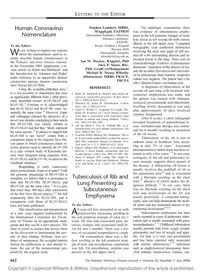
2006 Human Coronavirus Nomenclature PDF
Preview 2006 Human Coronavirus Nomenclature
LETTERS TO THE EDITOR Human Coronavirus Nomenclature To the Editor: W e are writing to express our concern about the nomenclature used to re- cently describe human coronaviruses in the Pediatric Infectious Disease Journal. In the November 2005 supplement, a re- view article by Kahn and McIntosh1 and the Introduction by Johnston and Kahn2 make reference to an apparently distinct coronavirus species, human coronavirus New Haven (hCoV-NH). Using the available published data,3 it is not possible to characterize this virus as significantly different from 2 other previ- ously described viruses: hCoV-NL634 and hCoV-NL.5 Fouchier et al acknowledged that hCoV-NL63 and hCoV-NL were “es- sentially the same virus.”5 However, Esper and colleagues claimed the discovery of a novel virus despite concluding in their article that HCoV-NH was closely related to HCoV-NL63 and that they “likely represent the same species.”3 Evidence to support that hCoV-NH is not “novel” comes from a companion paper to the original New Ha- ven paper in which polymerase chain re- action primers used to identify hCoV-NH in a case–control study of Kawasaki dis- ease were designed using sequence from hCoV-NL63 and hCoV-NL located on the GenBank database.6 Responding to early controversy about nomenclature, Esper et al stated “Until full genomic sequencing of HCoV-NH is complete, we believe that it is premature to state that HCoV-NH, HCoV-NL63, and HCoV-NL are the same virus.”7 It is a pity that more than 500 days after submission of the first New Haven articles,3,6 the full sequencing data for hCoV-NH, and a comparison with those of hCoV-NL63, have not been published. The classification and nomenclature of a new virus requires endorsement by the International Committee for Taxon- omy of Viruses or an appropriate study group and this can be a slow process. The onus of proof in science has always been on the discoverer to demonstrate the nov- elty of their finding. Without clear evi- dence of uniqueness, the accepted interim format for publication is, and should re- main, the use of the nomenclature pro- posed by the original study. Stephen Lambert, MBBS, MAppEpid, FAFPHM Queensland Paediatric Infectious Diseases Laboratory SASVRC Royal Children’s Hospital Herston 4029 Queensland, Australia
